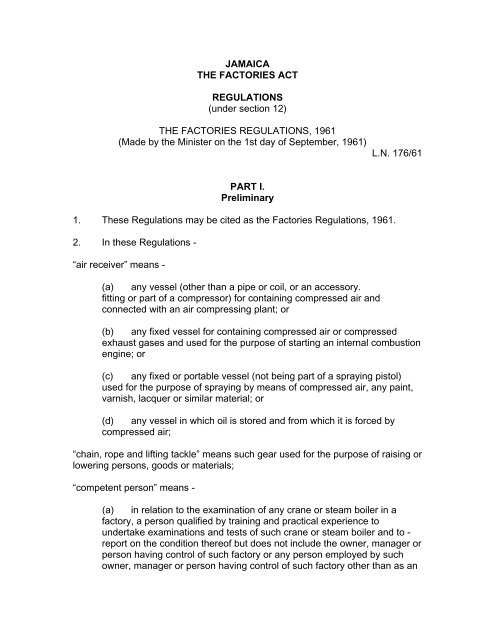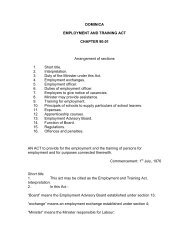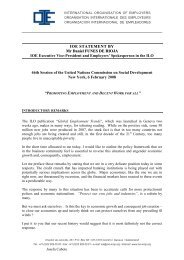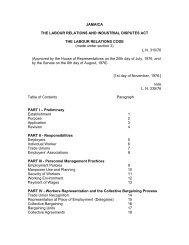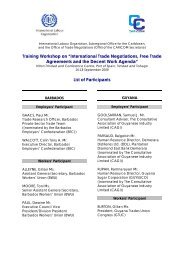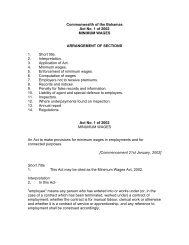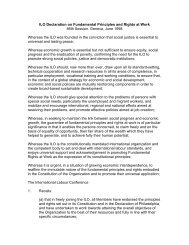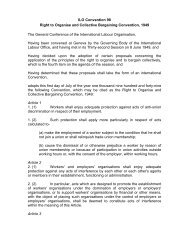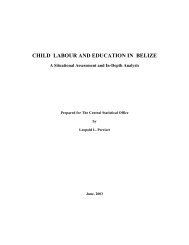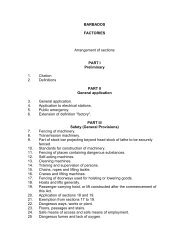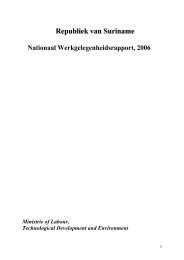JAMAICA THE FACTORIES ACT REGULATIONS (under ... - ILO
JAMAICA THE FACTORIES ACT REGULATIONS (under ... - ILO
JAMAICA THE FACTORIES ACT REGULATIONS (under ... - ILO
You also want an ePaper? Increase the reach of your titles
YUMPU automatically turns print PDFs into web optimized ePapers that Google loves.
<strong>JAMAICA</strong><strong>THE</strong> <strong>F<strong>ACT</strong>ORIES</strong> <strong>ACT</strong><strong>REGULATIONS</strong>(<strong>under</strong> section 12)<strong>THE</strong> <strong>F<strong>ACT</strong>ORIES</strong> <strong>REGULATIONS</strong>, 1961(Made by the Minister on the 1st day of September, 1961)L.N. 176/61PART I.Preliminary1. These Regulations may be cited as the Factories Regulations, 1961.2. In these Regulations -“air receiver” means -(a) any vessel (other than a pipe or coil, or an accessory.fitting or part of a compressor) for containing compressed air andconnected with an air compressing plant; or(b) any fixed vessel for containing compressed air or compressedexhaust gases and used for the purpose of starting an internal combustionengine; or(c) any fixed or portable vessel (not being part of a spraying pistol)used for the purpose of spraying by means of compressed air, any paint,varnish, lacquer or similar material; or(d) any vessel in which oil is stored and from which it is forced bycompressed air;“chain, rope and lifting tackle” means such gear used for the purpose of raising orlowering persons, goods or materials;“competent person” means -(a) in relation to the examination of any crane or steam boiler in afactory, a person qualified by training and practical experience to<strong>under</strong>take examinations and tests of such crane or steam boiler and to -report on the condition thereof but does not include the owner, manager orperson having control of such factory or any person employed by suchowner, manager or person having control of such factory other than as an
PART II.Safety3. (1) Every dangerous part of any machinery shall be securely fenced unless itis in such a position or of such construction as to be as safe to every worker as itwould be if securely fenced.In particular and without prejudice to the generality of the foregoing provision, thefollowing sub-paragraphs shall apply to every factory -(a) every flywheel directly connected to any prime mover and everymoving part of any prime mover except such prime movers as arementioned in sub-paragraph (Ii) shall be securely fenced, whether theflywheel or prime mover is situated in an engine house or not;(b) every part of electric generators, motors and rotary converters, andevery flywheel directly connected thereto, shall be securely fenced, unlessit is in such a position or of such construction as to be as safe to everyworker as it would be if securely fenced;(c) efficient devices or appliances shall be provided and maintained inevery room or place where work is carried on by which the power canpromptly be cut off from the transmission machinery in that room or place;(d) no driving belt when not in use shall be allowed to rest or ride upona revolving shaft which forms part of the transmission machinery;(e) suitable striking gear or other efficient mechanical appliances shallbe provided, maintained and used to move driving belts to and from fastand loose pulleys;(f) projecting set-screws, bolts or keys on any revolving shaft, spindle,wheel or pinion shall be securely fenced, cut off or counter-sunk;(g) all transmission machinery which runs at a height of less than 6jfeet from a floor or place to which persons have access shall be securelyfenced;(h) all vertical and inclined belts passing through floors or platformsshall be fenced to a height of at least 64 feet;(i) every part, <strong>under</strong> which persons walk or are likely to pass, of heavyoverhead belts, ropes or chains, shall be securely fenced;(j) all materials or articles projecting from revolving machines or partsthereof shall be securely fenced;
(k) no traversing part of any self-acting machine or any material carriedthereon or any material or article projecting from any reciprocatingmachine shall be allowed to traverse over any free space within a distanceof 18 inches from any fixed or rigid structure or object not being part of themachine;(l) all fencing or other safeguards provided in pursuance of theseRegulations shall be of substantial construction, and constantlymaintained and kept in position while the parts required to be fenced orsafeguarded are in motion or use, except when any such parts arenecessarily exposed for examination or for any lubrication or adjustmentshown by such examination to be immediately necessary:Provided that any such examination, lubrication or adjustment shall be carriedout only by persons specially appointed by the manager, and such persons shallnot be allowed to wear loose-fitting clothing or headgear.3. (2) No person shall sell, let on hire, or as agent of the seller or hirercause or procure to be sold or let on hire, for use in a factory in the Island anymachine intended to be driven by mechanical power which does not comply withthe requirement of sub-paragraphs (a), (Li) and (/) of paragraph (1), or which isnot provided with the appliances specified in sub-paragraph (e) of thatparagraph.3. (3) Where the Chief Factory Inspector is satisfied that there is availableand suitable for use in connection with machinery of any class, any type ordescription of safety device which -(a)(b)prevents the exposure of a dangerous part of machinery whilst inmotion; orstops a machine forthwith in case of danger,he may direct that the type or description of device shall be provided for use inconnection with such class of machinery as he may specify in such directions,and such device shall be provided:Provided that, in any proceedings in respect of a contravention of this paragraphit shall be a sufficient defence to prove that a device at least as equally effectivewas being used in connection with the machinery in respect of which thecontravention occurred.3. (4) Every fixed vessel, structure, sump or pit of which the edge is lessthan three feet six inches above the adjoining ground or platform shall, if itcontains any scalding, corrosive or poisonous liquid, either be securely covered
9. Where necessary, proper and effective precautions shall be takeneither by earthing or by other suitable means to prevent any metal other than aconductor from becoming electrically charged.10. Proper and effective precautions shall be taken to prevent anyconductor or equipment from being accidentally or inadvertently electricallycharged when persons are working thereon.In particular, all switches controlling such conductor or apparatus shall beopened and locked out and the key kept by the person in charge of the work untilit is completed. Where it is impracticable to lock out a switch, other effectivemeans of preventing danger shall be provided.11. Portable insulating stands, screens, boots, gloves or other suitablemeans of insulation shall be provided and used when necessary and shall beperiodically examined.12. All electrical conductors and apparatus exposed to the weather,moisture, corrosion, inflammable surroundings or explosive atmosphere. or usedin any process or for any special purpose shall be so constructed or protected asto prevent danger to life or limb from shock, burn, or injury to workers, or fromfire; and such special precautions shall be taken in the use of such conductors orapparatus as may be necessary in view of such exposure or use.In particular all electrical equipment installed in a location where the atmosphereis likely to become inflammable or explosive shall be of flame-proof or explosiveproofconstruction.13. All conductors ‘including earth continuity conductors between themain switch-gear and the consuming apparatus shall be protected againstmechanical damage and shall be so placed as not to cause obstruction. Flexibleconduit when used shall not exceed 6 feet in length.14. In every factory in which electrical energy is generated or transformedor is used for any purpose other than lighting, an adequate number ofposters giving instructions for the treatment of persons suffering from electricshock shall be conspicuously exhibited in locations where such instructions canbe easily read by persons employed in the factory.15. A boy <strong>under</strong> sixteen years of age or a woman shall not be allowedto clean any dangerous part of any machinery while the machine is in motion bythe aid of mechanical power.16. No person shall be allowed to operate any dangerous machine unless -(a)he is competent to do so or is directly <strong>under</strong> the supervision of a
person competent to operate such machine; and(b) he has been fully instructed as to the dangers attendant upon theoperation of such machine and the precautions to be taken.17. All floors, steps, stairs, passages and gangways and other parts ofevery factory shall be of Sound construction and properly maintained.18. Every ladder shall be soundly constructed and properly maintained,and so far as practicable be securely fixed, when in use, so that it can moveneither from its top nor from its bottom points of rest.19. Where necessary to prevent danger, substantial handrails shall beprovided and maintained at all stairways.20. All openings in floors shall be securely fenced, except in so far asthe nature of the work renders such fencing impracticable.21. Effective means shall be provided to prevent articles from fallingfrom elevated walkways, platforms and mezzanine floors.22. (1) Safe means of access shall be provided and maintained to everyplace in which any person has at any time to work.22. (2) Where any person is required to work at any place from which it ispossible to fall a distance of more than 6 feet 6 inches to the floor or on to anyobject over which the person is effective measures shall be taken to prevent anyperson falling to the floor or on to any object over which the person is working.23. The doors of every factory and, where practicable. the doors ofevery room therein in which more than ten persons are employed shall, except inthe case of sliding doors, be so constructed or altered as to open outwards.24. At least two separate means of escape in case of fire shall beprovided on each floor of every factory and such other means of escape in caseof fire shall be provided as may reasonably be required by the Chief FactoryInspector in each case.25. In every factory in which an outbreak of fire is likely to cause injuryto any person working therein suitable and sufficient fire extinguishing equipmentshall be provided.26. While any person is within a factory, for the purpose of employmentor meals, the doors of the factory and of any room therein in which the person is,shall not be locked or fastened in such a manner that they cannot be easily andimmediately opened from the inside.
27. (1) Every window, door or other exit affording means of escape in caseof fire or giving access thereto other than the means of exit in ordinary use, shallbe distinctively and conspicuously marked by a notice printed in red letters of anadequate size.27. (2) Where in any factory more than twenty persons arc employed in thesame building. or explosive or highly inflammable materials are stored or used inany building in which persons are employed, effective provision shall be made forgiving warning clear and audible throughout the building in case of fire.28. Every cold storage room in every factory shall be provided with anefficient means of giving clear and audible warning outside such room and suchmeans shall be capable of being operated from the inside of the cold storageroom.29. Effective steps shall be taken to ensure that all the personsemployed in a factory are familiar with the means of escape in case of fire andwith the routine to be followed in case of fire.30. (1) Where any work has to be done inside any chamber, tank or otherconfined space in which dangerous fumes or gases are liable to be present –(a) the confined space shall be provided with adequate means ofegress; and(b) no person shall enter the confined space for any purpose unlessthe following requirements are complied with—.(i) all practicable steps shall be taken to remove any fumes orgases which may be present and, unless it has been ascertainedby a suitable test that the space is free from dangerous fumes orgases, the person entering shall wear a belt to which there issecurely attached a rope of which the free end is held by a personoutside; or(ii) the person entering shall wear a suitable breathingapparatus.30. (2) No tank, pipe or vessel which contains or has contained anyexplosive or inflammable substance shall be subjected to any welding, brazing orsoldering operation, or to any other operation which involves the application ofheat, until such substance and any fumes or gases arising therefrom have beauremoved or rendered non-explosive or non-inflammable3l. (1) Every steam boiler whether separate or one of a range, shall have
attached to it-(a) a suitable safety valve, which shall be so adjusted as to prevent theboiler being worked at a pressure greater than the maximum permissibleworking pressure;(b)a suitable stop valve, connecting the boiler to the steam pipe;(c) a correct steam pressure gauge calibrated in pounds per squareinch which shall be easily visible to the boiler attendant and have markedupon the dial in distinctive colour the maximum permissible workingpressure; and(d) an adequately protected water gauge to show the water level in theboiler:Provided that sub-paragraph (b) shall not apply with respect toeconomizers and sub-paragraphs (c) and (d) shall not apply with respect to eithereconomizers or superheaters.31. (2) The dial of the steam pressure gauge shall be calibrated to not lessthan one and one-half times the maximum permissible working pressure.31. (3) The steam pressure gauge shall be connected to the boiler bymeans of a syphon or equivalent device of sufficient capacity to keep the gaugetube filled with water and such syphon or other device shall be so arranged thatthe gauge cannot be shut off from the boiler except by a cock or valve placednear the gauge.32. No person shall enter or be in any steam boiler which is one of a range oftwo or more steam boilers unless -(a) all inlets through which steam or hot water might otherwise enterthe boiler from any other part of the range are disconnected from that part;or(b) all valves or taps controlling such entry are closed and securelylocked, and, where the boiler has a blow-off pipe in common with one ormore other boilers or delivering into a common blow-off vessel or sump.the blow-off valve or tap on each such boiler is so constructed that it canonly be opened by a key which cannot be removed until the valve or tap isclosed and is the only key in use for that set of blow-off valves or tap.33. No steam boiler whether or not it has been previously used shall betaken into use in any factory for the first time in that factory until it has beenexamined and reported on by a competent person. A report of the result of such
examination shall be in the Form A in the First Schedule, be signed by theperson making the examination and be available for inspection at the factory.34. A lever-valve, fitted to a steam boiler shall not be deemed asuitable safety valve unless the weight is secured on the lever in the correctposition.35. Every steam boiler shall be provided with means for attaching a testpressure gauge.36. Every steam boiler shall be provided with a suitable fusible plug oran efficient low-water alarm device:Provided that this regulation and regulation 35 shall not apply with respect toeither economizers or superheaters.37. Every part of every steam boiler shall be of good construction,sound material, adequate strength and free from patent defect. All fittings andattachments shall be properly maintained.38. (1) Every steam boiler and all its fittings and attachments shall bethoroughly examined by a competent person at least once in every period oftwelve months, and also after extensive repairs.38. (2) A full and accurate report of the result of every such examinationshall be made in the Form A in the First Schedule by the person making theexamination, and, such person shall, within twenty-eight days after thecompletion of the examination, send a copy of the said report to the ChiefFactory Inspector.38. (3) The report referred to in paragraph (2) shall be kept at the factoryfor inspection.39. Every steam receiver not so constructed as to withstand with safetythe maximum permissible working pressure of the boiler or the maximumpressure which can be contained in the pipe connecting the receiver with anyother source of supply, shall be fitted with -(i) a suitable reducing valve or other suitable automaticappliance to prevent the safe working pressure frombeing exceeded;(ii)(iii)a suitable safety valve;a correct steam pressure gauge; and
(iv)a suitable stop valve.40. Every steam receiver and its fittings shall be properly maintainedand shall be thoroughly examined by a competent person, so far as theconstruction of the receiver permits, at least once in every period of twelvemonths. A record of such examination, in the Form B in the First Schedule,shall be kept available for inspection at the factory.41. Every steam container shall be so maintained as to secure that theoutlet is at all times kept open and free from obstruction.42. Every air receiver shall –(a) have marked upon it so as to be plainly visible the safe workingpressure in pounds per square inch;(b) in the case of a receiver connected with an air compressing planteither be so constructed as to withstand with safety the maximumpressure which can be obtained in the compression, or be fitted with asuitable reducing valve or other suitable appliance to prevent the safeworking pressure of the receiver being exceeded;(c) be fitted with a suitable safety valve so adjusted as to permit the airto escape as soon as the safe working pressure is exceeded;(d) be fitted with a correct pressure gauge indicating the pressure inthe receiver in pounds per square inch;(e)be fined with a suitable appliance for draining the receiver; and(f) be provided with a suitable manhole, handhole or other meanswhich will allow the interior to be thoroughly cleaned.43. Every air receiver and its fittings shall be of sound construction andproperly maintained and shall be thoroughly cleaned and examined by acompetent person at least once in every period of twelve months:Provided that in the case of a receiver of solid drawn construction and soconstructed that the internal surface cannot be thoroughly examined a suitablehydraulic test of the receiver shall be carried out in lieu of internal examination. Arecord of such test and examination shall be kept available at the factory andshall be in the Form B in the First Schedule.44. Regulations 42 and 43 shall apply, as far as practicable, to anyvessel containing gases at pressures higher than atmospheric without a constantoutlet to open air (not being a portable vessel filled by suppliers and delivered to
a factory) as if such vessel were an air receiver.45. The Chief Factory Inspector may. on such conditions as he maythink fit, by certificate exempt from any of the provisions of these Regulations anyclass or type of steam boiler, steam receiver, steam container or air receiver towhich he is satisfied that such provisions cannot reasonably be applied.46. No chain, rope or lifting tackle shall be used unless it is of goodconstruction, sound material, adequate strength and free from patent defect.47. All chains, ropes and lifting tackle in use shall be thoroughlyexamined by a competent person at least once in every period of six months, anda record of each examination shall be kept available for inspection at the factory.48. All parts of every lifting machine shall be of sound construction andfree from patent defect.49. All lifting machines shall be thoroughly examined by a competentperson at least once in every period of twelve months and a register in the FormC in the First Schedule kept of such examinations.50. There shall be plainly marked on every lifting machine the safeworking load or loads thereof, except that in the case of a jib crane, soconstructed that the safe working load may be varied by the raising or lowering ofthe jib, there shall be attached thereto either an automatic indicator of safeworking loads or a table indicating the safe working loads at correspondinginclinations of the jib or corresponding radii of the load.51. No lifting machine shall be loaded beyond the safe working load.52. No lifting machine shall be taken into use in any factory for the firsttime in the factory unless it has been tested and examined by a competentperson and a certificate of such test and examination specifying the safe workingload or loads of the machine and signed by the person making the test andexamination has been obtained and is kept available for inspection.53. Every crane operated wholly or partially by a prime mover shall beequipped with a gong or other effective audible signalling device automatic orotherwise, installed within easy reach of the operator for warning persons whomay be endangered by any movement of the crane or load.54. Every hoist or lift shall be securely fenced and in particular -(a) every hoist or lift shall be of good mechanical construction, soundmaterial and adequate strength, and be properly maintained;
(b) every hoist or lift shall be examined by a competent person at leastonce in every period of six months and records of such examinations shallbe kept available at the factory;(c) every hoistway or liftway shall be effectively protected by asubstantial enclosure fitted, with gates, being such an enclosure as toprevent, when the gates are shut, any person from falling down the way orcoming in contact with any moving part of the hoist or lift:Provided that if it is shown to the satisfaction of the Chief Factory Inspector that itwould be unreasonable in the special circumstances of the case to enforce anyrequirement of this regulation, he may direct that such requirement shall notapply.55. (1) No hoist or lift shall be used for carrying persons unless it isprovided with a cage, which is -(a) so constructed as to prevent, when the cage gate or gates are shut,any person carried from falling out or from being trapped between any partof the cage and any fixed structure or other moving part of the hoist or liltor from being struck by articles or materials falling down the hoistway; and(b) fitted on each side from which access is provided to a landing placewith a gate with efficient interlocking or other device to secure that thegate cannot be opened except when the cage is at a landing place, andthat the cage cannot be moved away from any such place until the gate isclosed.55. (2) Every gate in the hoistway or liftway enclosure of a hoist or lift usedfor carrying persons shall be fitted with efficient interlocking or other devices tosecure that the gate cannot be opened except when the cage is at the landingplace. and that the cage cannot be moved away from the landing place until thegate is closed.55. (3) In connection with every hoist or lift used for carrying persons there shallbe provided suitable efficient automatic devices which will ensure that the cagecomes to rest at a point above the lowest point to which the cage can travel.56. In the case of a hoist or lift used for carrying persons the maximumnumber of persons to be carried at any one time shall be plainly marked thereon,and a greater number of persons shall not be carried.57. In all places to which these Regulations apply a person shall be appointedto exercise supervision of the works, machinery and plant, for the purpose ofensuring safety. It shall be the duty of the person so appointed to see that allsafeguards and other safety appliances are maintained in proper order and
position and to investigate accidents. Nothing in this regulation shall relieve theowner, manager or person having control of the factory of his duties <strong>under</strong> theseRegulations.58. (1) Where the Chief Factory Inspector is not satisfied as to thecompetency of the person employed to make any examination <strong>under</strong> theforegoing regulations or as to the thoroughness of the examination he mayrequire a further examination to be carried out by a competent person nominatedby him and the necessary facilities for such examination shall be provided.58. (2) If as a result of such re-examination it appears that the report of thefirst examination was inadequate or incorrect in any particular, the cost of the reexaminationshall be recoverable at the suit of the Attorney-General from theowner, manager or person having control of the factory summarily as a civil debt.PART IIIHealth and Welfare59. (1) Every factory shall be kept in a clean state, and free from effluviaarising from any drain or sanitary convenience, and without prejudice to thegenerality of the foregoing provision –(a) suitable covered receptacles shall be provided in the factory for thedisposal of dirt and refuse;(b) accumulations of dirt and refuse shall be removed daily from the floorsand benches of workrooms, and from the staircases and passages;(c) the floor of every workroom shall be cleaned at least once in everyweek by washing or if it is effective and suitable by sweeping or othermethod;(d) all inside walls and partitions, and all ceilings or tops of rooms, and allwalls, sides and tops of passages and staircases shall—(i) where they have a smooth impervious surface, at least oncein every period of twelve months be thoroughly cleansed;(ii) where they are painted or varnished, be repainted orrevarnished at least once in every period of seven years and atleast once in every period of twelve months be thoroughlycleansed;(iii) in other cases be kept white washed or colour washed, andthe white washing or colour washing shall be repeated at least once
in every period of twelve months:Provided that where it appears to the Chief Factory Inspector that any of therequirements of sub-paragraphs (a) to (d) are by reason of special circumstancesinappropriate in any factory he may. if he thinks fit –(a) direct in writing that such of those requirements as he may specifyshall not apply; and(b) substitute therefor such other requirements as he may considernecessary.59. (2) A record shall be kept of the dates of washing, white washing orcolour washing, painting or varnishing of the factory.60. A factory shall not, while work is carried on, be so overcrowded asto cause risk or injury to the health of the persons employed therein and, withoutprejudice to the generality of the foregoing provisions -(a) a factory shall be deemed to be overcrowded, as aforesaid, if thenumber of persons employed at a time in any workroom is such that theamount of cubic space allowed for every person employed in the room isless than 400 cubic feet;(b) in calculating, for the purpose of this provision, the amount of cubicspace in any room, no space more than 14 feet from the floor shall betaken into account and, where a room contains a gallery, the gallery shallbe treated for the purposes of this provision as if it were partitioned offfrom the remainder of the room and formed a separate room.61. Effective and suitable provisions shall be made for securing andmaintaining by the circulation of fresh air in each workroom the adequateventilation of the room and for rendering harmless, as far as practicable, allfumes, dust and other impurities that may be injurious to health generated in thecourse of any process or work carried out in the factory.62. Effective provision shall be made for securing and maintainingsufficient and suitable lighting, whether natural or artificial, in every part of afactory in which persons are working or passing.63. (1) The general illumination over those interior parts of a factory wherepersons are regularly employed shall be not less than six foot-candles measuredin the horizontal plane at a level of three feet above the floor.63. (2) The illumination over all other interior parts of the factory overwhich persons employed pass shall when and where a person is passing be not
less than two foot-candles measured at floor level.63. (3) The standards specified in paragraphs (1) and (2) shall be withoutprejudice to the provision of any additional illumination required to render thelighting sufficient and suitable for the nature of the work.64. (1) Effective provision shall be made for securing and maintaining areasonable temperature in each workroom, but no method shall be employedwhich results in the escape into the air of any workroom of any fume of such acharacter and to such extent as to be likely to be injurious or offensive to personsemployed therein.64. (2) Where humidity is artificially produced or regulated at any factory orpart of any factory in which persons are employed, the Chief Factory Inspectorshall approve the humidity which shall be maintained therein and the owner,manager or occupier of such factory shall keep therein such instruments andrecords as may be necessary to show the humidity being maintained.65. Where any process is carried on which renders the floor liable to bewet to such an extent that the wet is capable of being removed by drainage,effective means shall be provided and maintained for draining off the wet. Alldrainage and effluents shall be disposed of in a sanitary manner. In a seweredarea such drainage and effluents shall be discharged to sewers in compliancewith any safeguard required by the sewerage authority. All such arrangementsshall be sanitary and shall not create a nuisance.66. Sufficient and suitable sanitary conveniences for the personsemployed in the factory shall be provided, maintained and kept clean and thefollowing requirements shall have effect –(a) in cases where females are employed there shall be at least onesuitable sanitary convenience for every 25 females:(b) in cases where males are employed there shall be at least onesuitable sanitary convenience (not being a convenience suitable merely asa urinal) for every 25 males;(c) in the case of factories where the number of males employedexceed 100 and sufficient urinal accommodation is also provided, it shallbe sufficient if there is one such convenience as aforesaid for every 25males up to the first 100. and one for every 50 thereafter;(d) in calculating the number of conveniences, any number of personsless than 25 or 50, as the case may be, shall be reckoned as 25 or 50;(e)in cases where persons of both sexes are employed the sanitary
conveniences for each sex shall be separate and suitably placed;(f) every sanitary convenience shall be sufficiently ventilated and nosanitary convenience shall communicate –(i)with any workroom; or(ii) with any enclosed space which also communicates with anyworkroom, unless such space is adequately ventilated.67. (1) An adequate supply of wholesome drinking water shall be providedat points conveniently accessible to all persons employed in the factory. Thesource of supply shall, where the Chief Factory Inspector so requires, beapproved in writing by a Medical Officer (Health).67. (2) A supply of drinking water which is not laid on shall be contained insuitable vessels, and shall be renewed at least daily, and all practicable stepsshall be taken to preserve the water and vessels from contamination.68. There shall be provided and maintained for the use of personsemployed adequate and suitable facilities for washing, which shall be separatefor each sex and shall include basins, soap and clean towels. The Chief FactoryInspector, may, if he thinks fit, owing to the difficulty of obtaining an adequatesupply of water or in such other special circumstances, modify this requirement inrespect of any factory.69. In every factory in which women are employed in an industrialprocess, a suitable restroom shall be provided, which shall be equipped withadequate and suitable facilities for resting and shall be placed <strong>under</strong> the chargeof a responsible person and properly maintained.70. There shall be provided and maintained for the use of employedpersons adequate and suitable facilities for changing of clothing and foraccommodating clothing not worn during working hours. Separateaccommodation shall be provided for persons of each sex and shall, when sorequired by the Chief Factory Inspector, include adequate shower bath facilities.71. There shall be provided and maintained for the use of employees asuitable and adequate lunch-room, which shall be furnished with—(a) sufficient tables and chairs or other suitable seating accommodation;(b)adequate means, including hot water, for the washing of dishes.The Chief Factory Inspector may, if he thinks fit, in any special circumstances,
modify this requirement in respect of any factory.72. (1) In every factory the following requirements shall have effect –(a) there shall be provided and maintained so as to be readilyaccessible an appropriate number of first-aid boxes or cupboardscontaining the equipment specified in the Second Schedule and nothingexcept appliances or requisites of first-aid shall be kept in such boxes orcupboards;(b) every first-aid box or cupboard shall be placed <strong>under</strong> the charge ofa responsible person who shall be available to render first-aid treatmentwhenever work is being carried on in the factory and where thirty or morepersons are at work at any one time, the person in charge of the first-aidbox shall be a person trained in first-aid treatment including competency toadminister artificial respiration;(c) in every factory in which electrical energy is generated ortransformed at least one person who has been trained to administerartificial respiration shall be present in the factory when work is carried on;(d) the appropriate number of first-aid boxes or cupboards for thepurposes of this regulation shall be determined as follows -(i) one box or cupboard if the number of employees does notexceed one hundred;(ii) if the number of employees exceeds one hundred anadditional box or cupboard shall be provided for each one hundredemployees or any part of that number in excess of the first onehundred employees;(iii) the largest number of persons employed at the factory at anyone time shall be regarded as the number ofpersons employed at that factory.72. (2) If a first-aid room is provided at the factory and such arrangementsare made as to ensure the immediate treatment there of all injuries occurring inthe factory, the Chief Factory Inspector may exempt the factory from therequirements of paragraph (1) to such extent and subject to such conditions ashe may specify in writing.73 (1) Where any persons employed in a factory have in the course oftheir employment reasonable opportunities for sitting without detriment to theirwork, there shall be provided and maintained for their use suitable facilities forsitting sufficient to enable them to take advantage of those opportunities.
73. (2) Where a substantial proportion of any work can properly be donesitting -(a) there shall be provided and maintained for any person employed inthat work a seat of a design, construction and dimensions suitable for himand the work, together with a foot-rest on which he can readily andcomfortably support his feet if he cannot do so without a foot-rest; and(b) the arrangements shall be such that the seat is adequately andproperly supported while in use for the purpose for which it is provided.73. (3) For the purposes of this regulation, the dimensions of a seat whichis adjustable shall be taken to be its dimensions as for the time being adjusted.74. (1) In every factory in which, in connection with any process carried on.there is given off any dust or fume or other impurity of such a character and tosuch extent as to be likely to be injurious or offensive to the persons employed,or any substantial quantity of dust of any kind, all practicable measures shall betaken to protect the persons employed against inhalation of the dust or fume orother impurity and to prevent its accumulating in any workroom. In particular,suitable goggles or other means of protecting the eyes, and suitable respiratorsshall be provided for the use of the persons employed, and where the nature ofthe process makes it practicable, exhaust appliances shall be provided andmaintained as near as possible to the point of origin of the dust or fume or otherimpurity, so as to prevent it from entering the air of any workroom.74. (2) Where any process carried on in a factory gives rise to any harmfuldust or fumes, no person shall be permitted to keep or partake of food or drink orto smoke in the workroom in which such process is carried on.74. (3) Where steam is discharged in any workroom in which workers areemployed, steps shall be taken by means of fans or other effective means todissipate the steam.74. (4) No stationary internal combustion engine shall be used unlessprovision is made for conducting the exhaust gases from the engine into theopen air.75. In the case of the following processes, suitable goggles or effectivescreens shall be provided to protect the eyes of the persons employed in theprocesses -(a)(b)dry grinding of metals or articles of metals;turning (external or internal) of non-ferrous metals, or of cast iron,
or of articles of such metals or such iron, where the work is done dry,other than precision turning where the use of goggles or a screen wouldseriously interfere with the work, or turning by means of hand tools;(c) welding or cutting of metals by means of an electrical oxyacetyleneor similar process;(d) the following processes when carried on by means of hand tools orother portable tools—(I)fettling of metal castings involving the removal of metal;(ii) cutting out or cutting off (not including drilling or punchingback) of cold rivets or bolts;(iii) chipping or scaling of boilers or ship plates;(iv) breaking or dressing of stone, concrete or slag.76. There shall be provided and maintained in good condition -(a) suitable waterproof boots or dry platforms or mats for the use of allpersons employed in processes which would otherwise necessitate theirworking or standing on wet surfaces;(b) suitable protective clothing including overalls, aprons, gloves,gauntlets. face shields and boots for the use of persons required to handleadds or other corrosive substances in the course of their work;(c) suitable warm clothing, including head covering and footwear, forthe use of persons employed in rooms having a temperature below 60degrees Fahrenheit,77. Where it appears to the Chief Factory Inspector that in any factory -(a) cases of illness have occurred which he has reason to believe maybe due to the nature of a process 01 other conditions of work; or(b) by reason of any process or in the substances used in anyprocess, there may be risk of injury to the health of persons employed inthat process.he may notify the Chief Medical Officer who shall thereupon appoint a MedicalOfficer to investigate and report. The Medical Officer appointed <strong>under</strong> thisregulation shall have the like powers as an Inspector <strong>under</strong> section 18 of the Act.
PART IVDuties78. It shall be the duty and responsibility of the owner, manager orother person having the management or control of any factory to comply with theprovisions contained in Parts II and III of these Regulations with the exception ofregulation 77.79. No person employed in any factory shall -(a) wilfully interfere with or misuse any means, appliance or other thingprovided in pursuance of these Regulations for securing the safety of theworkers employed therein, and where any means or appliance forsecuring safety is provided for the use of any such person <strong>under</strong> theseRegulations. he shall use the means or appliances;(b) wilfully and without reasonable cause do anything likely toendanger himself or others;(c) wilfully interfere with or misuse any means, appliance, convenienceor other thing provided in pursuance of these Regulations for securing thehealth and welfare of the persons employed in the factory, and where anymeans or appliance is provided for the use of any such person. he shalluse such means or appliance.PART V.Forms and Fees80. (1) The fees to be paid for the registration and renewal of registrationof any factory shall be determined by the number of employees in that factory, inaccordance with the scale set out in the Third Schedule.80. (2) The fees to be paid for the registration or renewal of registration ofa factory shall be paid -(a) in full at the time of application, for registration or renewal ofregistration (as the case may be) of such factory; or(b) in three equal annual payments, the first at the time of applicationfor registration or renewal of registration (as the case may be) of suchfactory and the second and third before the end of the first and secondperiods of twelve months thereafter respectively:Provided that if the second instalment is not paid before the end of thefirst period of twelve months specified in this sub-paragraph the whole
amount of the unpaid fee for the registration or renewal of registration ofsuch factory shall thereupon become payable.81. The Forms of Certificate of Registration and Re-registration shall beas set out in the Fourth Schedule.FIRST SCHEDULEFORM A(Regulations 33 and 38)Report on Examination and Test of Steam Boiler1. Name of Factory: _______________________2. Address: _______________________3. Name of Owner _______________________4. Name of Manager _______________________5. Description or distinctive number of boiler, and type: _________________6. Age: _______________________7. The history should be briefly stated or reference made to record in earlierreports: _______________________8. Date of hydraulic test and pressure applied: ____________________9. Quality and source of feed water: _______________________10. Boiler -(a) Was the boiler scaled, prepared, and (so far as itsconstruction permits) made accessible, sufficiently for thoroughexamination and for such tests as may be necessary in order tocomplete the thorough examination? ____________________(b) What parts of seams, drums or headers are covered bybrick work? __________________________________(c) Date of last exposure of such parts for the purpose ofexamination._____________________________________(d) What parts (if any) other than parts covered by brick workand mentioned above were inaccessible? ___________________(e) What examination and tests were made?______________(f) Condition—State any defects materially affecting the permissible workingpressure.External __________________Internal ___________________11. Mountings—(a) Are there proper mountings, including safety valve, water gaugeand steam gauge? ________________________________(b) Are all mountings properly maintained and in good working order?
_____________________(c) Are the water gauges protected? ____________________(d) Is there a low water alarm device or fusible plug fitted? Which?___________________________12. Permissible working pressure for the ensuing 12 months (subject to anyconditions stated in paragraphs 13 and 14) calculated from dimensions and fromthe thickness and other data ascertained by the present examination, dueallowance being made for conditions of working if unusual or exceptionallysevere. _____________________________________________13. Repairs (if any) required, and period within which they should beexecuted. ______________________________________14. Other observations :_____________________________________________________________________________________________________________________________________________________________________________________________I CERTIFY THAT on ___________________________ , I thoroughlyexamined the boiler above described, that the above is a true report of theresult, and that I am not the owner of the boiler nor am I employed by theowner in any capacity other than as an independent contractor.Signature: __________________________Qualification: ________________________Address : ___________________________Date : ______________________________FORM B(Regulations 40, 43, 44)Report on Examination and Test of Steam Receiver and Air Receiver1. Name of Factory __________________________2. Address __________________________3. Name of Owner __________________________4. Name of Manager __________________________5. Description or distinguishing number or mark (if any) of air receiver orsteam receiver. __________________________6. Nature of Examination__________________________7. Hydraulic pressure applied__________________________8. Condition -State any defects materially affecting the permissible working
pressureExternal _________________________Internal __________________________9. Mountings—.(a) Are there proper mountings including safety valves and pressuregauge? __________________________(b) Are all mountings properly maintained and in good working order?__________________________(c) Is the permissible working pressure marked on the receiver?__________________________10. Permissible working pressure for the ensuing 12 months__________________________I CERTIFY THAT on ______________________, I thoroughly examined the(steam receive, or air receive,) above described and that the above is a true report of theresult.Signature: __________________________Qualification: ________________________Address : ___________________________Date : ______________________________FORM C(Regulation 49)Report on Examination and Test of Lifting MachineI. Name of Factory __________________________2. Address __________________________3. Name of Owner __________________________4. Name of Manager __________________________5. Distinguishing number or mark (if any) and description sufficient to identifythe crane or other lifting machine. __________________________6. Date of examination made <strong>under</strong> regulation 49 and by whom it was carriedout__________________________7. Particulars of any defect found on examination and affecting the safe
working load, and of the steps taken to remedy such defect.__________________________8. The safe working load for the ensuing 12 months_________________________I CERTIFY THAT on_____________________________, I thoroughly examinedthe (crane or other lifting machine) above described and that the above is a true report ofthe result.** (Further certificate in case of crane only).I FUR<strong>THE</strong>R CERTIFY that I am not the owner of the crane nor am I employed bythe owner in any capacity other than as an independent contractor.** Delete if not applicable.Signature: __________________________Qualification: ________________________Address : ___________________________Date : ______________________________SECOND SCHEDULE(Regulation 72)12 packets absorbent gauze (sterilized)12 packets cotton wool (sterilized)6 muslin bandages 2” x 5 yds.6 muslin bandages 1” x 5 yds.2 triangular bandages1 spool adhesive tape I” x 5 yds.1 box safety pins1 pair scissors1 pair dressing forceps1 bottle (6 oz.) Aromatic Spirit of Ammonia1 bottle (4 on.) antiseptic1 bottle (8 on.) iodine6 tubes burn ointment4 splints 23” x 153”1 tourniquet4 rolls splint padding
1 kidney tray1 thermometer1 bottle Rectified Spirits (6 oz.)THIRD SCHEDULE(Regulation 80)Fees to be paid for Registration or renewal of Registration of a Factory.Number of employeesAmount of Fees10 and <strong>under</strong> $ 3.0011 to 30 $ 7.5031 to 60 $ 8.0061 to 100 $ 30.00101 to 200 $ 45.00201 to 400 $ 60.00401 to 600 $ 90.00601 to 800 $120.00Over 800 $150.00FOURTH SCHEDULEForm A(Regulation 81)Certificate of RegistrationIt is hereby certified that the factory known as ___________________________________________________ and owned by ____________________________at__________________________________________has been registered <strong>under</strong>the Factories Act. This certificate is valid for 3 years from the date of issue.Dated this__________ day of__________ 19 ___Chief Factory Inspector
Form BCertificate of Re-RegistrationIt is hereby certified that the factory known as_________________________________________________ and owned by _____________________________at_______________________________________has been re-registered <strong>under</strong>the Factories Act. This certificate is valid for 3 years from the _______________day of ______________________19 _______.Dated this__________ day of__________ 19 ___Chief Factory InspectorIndex to the Factories Regulations, 1961SubjectsRegulationsPART I — Preliminary 1-2PART II — Safety 3-59PART III — Health and Welfare 59-77PART IV — Duties 78-79PART V — Forms and Fees 80FIRST SCHEDULE-Form A - Report on examination and test of steam boiler 33, 38Form B – Report on examination and test of steamReceiver and air receiver 40, 43, 44Form C—Report on examination and test of lifting machine 49SECOND SCHEDULEFirst Aid Equipment 72THIRD SCHEDULEFees to be paid for registration or renewal of 80registration of a factoryFOURTH SCHEDULEForm A -Certificate of Registration 81Form B -Certificate of Re-Registration 81ACCESS TO WORK PLACE 22ACIDENT - Investigation of by Safety Supervisor 57
AIR RECEIVER (See Receiver-Air) 42-43BELTS - Driving3 (d),(e),(h)BOILERS—SteamChipping and scaling of—protection required75(iii)Construction and maintenance of 39-40Examination and Report on 33, 38Exemption from provision of Regulations 45Fittings of 31, 35, 36Safety requirements 31-38BOYS UNDER SIXTEEN YEARS OF AGERestriction re Dangerous Machinery 15BREATHING APPARATUS—Provision of in certain circumstances30(i)CEILINGS – cleaning, painting and washing of 59CERTIFICATES—Examination or Lifting Machines 52Examination of Steam Boilers 33, 38Registration and Re-Registration of Factory 81CHAIN – Lifting ofConstruction of 46Examination and Record of 47CHAIN – TRANSMISSION – Fencing of3(i)CHANGING ROOM – Provision of 70CLEANING - Washing or Painting of Factory and Record thereof 59CLOTHING –Facilities for Changing 70Persons examining, lubricating or adjustingmachinery in motion3(i)COLD STORAGE ROOM: Warning Device to be installed therein 28CONCRETE - Protection when breaking or dressing75(iv)CONTAINER—SteamMaintenance of 41Exemption from provisions of Regulations 45Fittings of 42
. . - .. . -.CONTROL DEVICES AND APPLIANCES3(c)CRANES (See Lifting Machines)DANGEROUS FUMESPrecautions necessary where work has to be done inchamber, tank or other confined spaces 30Application of heat to tank or vessel 30(2)DANGEROUS MACHINERYBoy or woman not allowed to clean while in motion 15Examination, cleaning, lubrication, adjustmentof, clothing of attendant 3(1)Fencing and other precautions 3Operators to be instructed re dangers andprecautionary measures 16DANGEROUS PROCESSESPrecautions re 75DEFINITIONSAir Receiver 2Chain, Rope and Lifting 2Competent Person 2Hoist or Lift 2Lifting Machine 2Lifting Tackle 2Maximum Permissible 2Prime Mover 2Steam Boiler 2Steam Container 2Steam Receiver 2Transmission Machinery 2Woman 2DoorsExcept sliding doors, to open outwards 23To be easily opened from inside 26DRAINAGE AND PERFUMES - Disposal of 65DUST - Protection Against 74
DUTIES AND RESPONSIBILITIESOwner, Manager or other person having control of factory 78Employees 79ECONOMIZERS 31, 36ELECTRICAL APPARATUS – Portable 5ELECTRICAL CONDUCTORS AND APPARATUS 12ELECTRICAL GENERATORS, MOTORS,ROTARY, CONVERTERS, ETC.Fencing of3(B)ELECTRIC MOTORS - Control of 4ELECTRIC SWITCHBOARDS 7EMPLOYEES—Duties and Responsibilities 79ENGINES - Fencing of 3EXAMINATION, RE-EXAMINATION ANDTESTING OF EQUIPMENT 38-58EXIT 24, 27(1)EXPLOSIVE OR INFLAMMABLE SUBSTANCEWarning Device to be provided for buildings containing 27(2)Prohibition of application of heat to vessels containing 30(2)EYES - Protection of 75F<strong>ACT</strong>ORYAccess to 22Cleaning, painting and washing of 59Lighting of 62Ventilation of 61FEES, REGISTRATION80 & 3 RDScheduleFENCING OF MACHINERY 3FIREEscape 24
Exits 26, 27(1)Extinguishing equipment 25Warning 27(2), 28Workers to be familiar with means of escapeand routine to be followed 29FIRST AIDEquipment of Box or Cupboard, number of boxesappointment and training of person in charge 72FLOORSConstruction and Maintenance of 17Cleaning of 59Draining of 65Openings in—to be fenced where practicable 20FLYWHEEL—Fencing of3(a)FUMES AND GASES—protective requirements 30, 74GANGWAYS - Construction and Maintenance of 17GEAR, STRIKING - Provisions of3(e)GOOGLES - Provision of 74(i), 75GRINDING—Dry 75HANDRAILS - To be provided where necessary 19HOIST OR LIFTConstruction, fencing, fittings, maintenance, examinationand record of 54, 55-58ILLNESS (due to process or conditions of work)Notification to Chief Medical Officer 77Investigation and report by Medical Officer 77LADDERS – Construction of and Maintenance of 18LAVATORIES—Provision of 66LIFTING MACHINEConstruction of 48Examination, testing and record of 49, 52Safe Working Load -. 50
LIFTING TACKLEConstruction of 46Examination of 47LIGHTING 62, 63LUNCH ROOM - Provision of 71MACHINES (See Dangerous Machinery and Fencing of Machinery)MANAGER OR PERSON HAVING CONTROL OF F<strong>ACT</strong>ORYDuties and Responsibilities 78METALSCutting, Dry Grinding, Fettling and Turning of 75OPENINGS IN FLOORS—to be fenced where practicable 20OVERCROWDING - How determined 60OWNER OF F<strong>ACT</strong>ORY - Duties and Responsibilities 78PASSAGES - Construction and Maintenance of 17PINION - Fencing ofPOWER - Control of3(f)3(c)RECEIVER - AirConstruction, maintenance, examination and record 43Fittings 42Exemptions from provisions of Regulations 45RECEIVER - STEAMConstruction, Fittings and Maintenance 39, 40Examination and record of 40Exemption from provisions of Regulations 45RECORDSExamination of Air Receiver 43Examination of Steam Receiver 40Examination of Chains, Ropes and Lifting Tackle 47Examination of Cranes and Lifting Machines 49, 52Examination of Hoist or Lift54(ii)Washing, Lime washing, Painting, Varnishing, etc. 59(2)
REGISTRATION AND RE-REGISTRATION - Certificate of 81REST ROOM - With suitable facilitiesProvision of 69ROPE - LiftingConstruction 46Examination 47ROPE - TransmissionFencing of3(i)ROOMSCleaning and washing of 59SAFETY APPLIANCESInterference with or misuse of 79Maintenance of 57SANITARY CONVENIENCESNumber of, situation and ventilation of 66SCREENS - For protection of eyes 75SHAFT - RevolvingFencing of3(f)SOLDERING 20.(2)SPINDLE - Fencing of3(f)STAIRS AND STAIRWAYSConstruction and Maintenance 18Handrails 19Cleaning of59(d)STEAM BOILERS (See Boiler—Steam)STEAM C0NTAINER (See Container—Steam)STEAM RECEIVER (See Receiver—Steam)STEPS - Construction and Maintenance of 6STONE - Breaking or Dressing of75(iv)
STRIKING GEAR3(e)SUPERHEATER 17, 20SUPERVISION OF WORKS AND MACHINERY 57TRANSMISSION MACHINERYFencing, examination, lubrication or adjustmentURINALSVENTILATION3(g)66(c)61, 66(f)WALLSCleaning and Washing of 59WASHING—Facilities for 68WATER, DRINKING 67WELDING - protection required for 75WOMENProvision of changing and rest rooms, sanitaryconveniences and washing facilities 66, 68, 69 & 70Restriction re dangerous machinery 15


